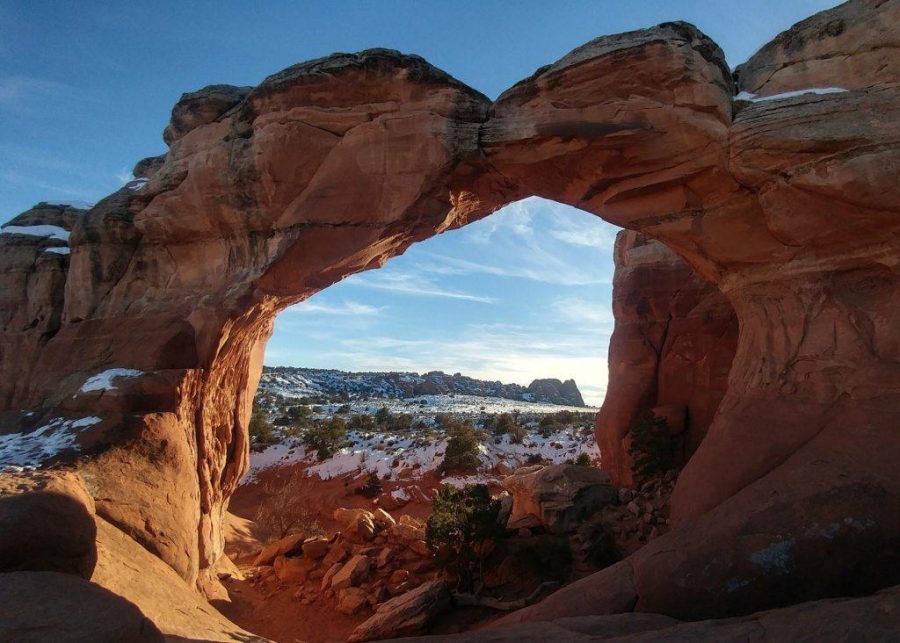The minute I poked my head through the flaps of the old spring bar tent I knew it was worth it. Red-orange dirt glistened with frost. Sagebrush, juniper and yucca plants defied the snowy landscape with their bursts of green. Cotton candy clouds floated against the pristine cerulean sky. I stepped outside, balancing haphazardly as I shoved cold toes into my hiking boots and took a deep breath. The scenery was one thing, but the cold, clean air rushing into my lungs slapped a smile on my face.
I’m not sure exactly where the idea had originally come from, only that for the last six months I’d been stuck with an unrelenting desire to go camping in Moab. Unfortunately, I was always busy, couldn’t find anyone to go with, had mountains of homework or the plans never got off the ground. Finally, here I was. In the few short days between the holiday season and the new semester, I pulled together a small group and off we went.
Although I love the outdoors, this was my first camping excursion since I was a child. We borrowed my parents’ ancient tent, which we were informed by a park ranger was “a classic.” It took up a quarter of the packing space in my hatchback, leaving little room for bulky sleeping bags, cookware and as many warm layers as we could fit in our duffel bags. It was a conglomerate of dysfunctionality, but we made it work.
We rolled into Dead Horse Point State Park at around 10:30 P.M. and began to set up our campsite. I’d put up a few tents before, and, coupled with the short YouTube video I had watched, I figured we would have no problem with the dusty old tent.
Snow covered the frozen ground, making it nearly impossible to pound in the tent stakes. The poles were stuck from years of disuse and wouldn’t extend enough to bear the height of the tent. Our hands were freezing. We were exhausted, hungry and — honestly — grouchy. With a spur of innovation, we propped up the short poles with chunks of sandstone and declared the swaying tent sound enough to sleep in. One rushed and lukewarm dinner later, we bunkered down for the night.
We’d checked the weather and let me tell you, 14 degrees is much less inviting than it sounds. I woke up in the middle of the night focused vividly on a passage I once read which described how Antarctic explorers often sleep with their feet tucked next to each other’s stomachs to prevent frostbite.
In the morning, we made our way to the overlook at Dead Horse Point before driving to Arches National Park. As we made our way toward the campground for another cold night, we stopped to stretch our legs and take in breathtaking views of the snow-covered rock formations. In the summer, the paths would have been crowded with tourists milling about and snapping photos. In the middle of January, all was relatively silent with just a few onlookers.
The campground we stayed at is directly next to the park’s longest hike, a 7.8-mile loop called Devil’s Garden. We dedicated a whole day to the hike, which might have been overkill if not for the icy trails. In hindsight, we should have expected that snow-covered southern Utah would feature snow-covered hiking, but by the time we put two and two together we were well on our way. We were nearly to Double O Arch when we finally succumbed — the steep, frozen pathway could take us no further. We rested before our return, looking out from the top of a ridge across the plains.
The contrast of the stark snow against gleaming red sandstone isn’t something many people get to see. The park is much more inviting in the summer when temperatures rise above freezing, but something about winter in the red rocks is magical. It’s as though Utah’s best come together all in one place: the shimmering snow and the twisted formations unite to create something entirely unique. Despite our chilled mishaps and gelid slumbers, the clear smell of that first morning in Southern Utah’s red rocks made it all worth it. Camping in January may not have been my smartest idea, but it was one of my best. Everyone should experience Moab’s winter majesty.
@TheChrony


